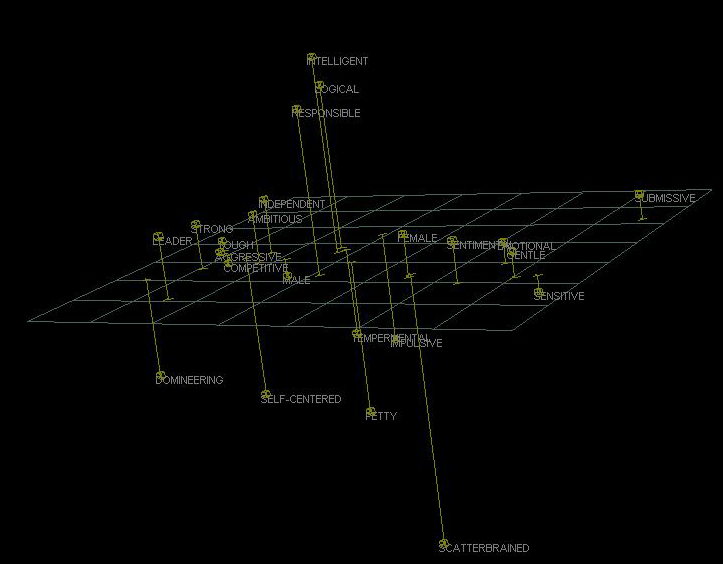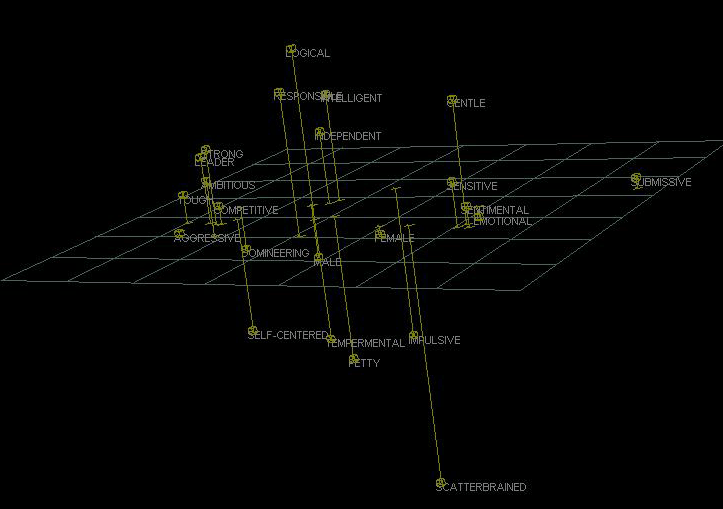| |
The Galileo Group at Albany
As evidence for the non-Euclidean character of cognitive maps grew,
the psychometric community continued to struggle with methods to
force euclidean solutions. One particularly troublesome dataset
that made the rounds of developers was the “tea tasting data”.
No known MDS program in the psychometric community could solve the
tea tasting data, for a simple reason: people like hot tea, and
they like iced tea, but most people do not like tepid tea. In a
cognitive space, this means that the ideal point -- the point most
preferred -- must lie close to iced tea, and close to hot tea, but
not close to tepid tea, which, of course, lies between iced and
hot tea. This is not possible in any euclidean space, but is simple
in a riemann space which is warped so that iced tea and hot tea
are closer to each other than they are to tepid tea. The Galileo
program, using classical Young Householder Torgerson methods, solves
this problem exactly.
The sizes problem
The first Galileo ever made was a picture of Alice in Wonderland.
Students were asked to estimate the distances between objects in
the picture, and the general form of the picture could be reproduced
from the Galileo coordinates. What the picture made graphically
evident was that the objects in the picture, unlike the ideal points
in hypothetical multidimensional scaling spaces, were not points
at all, but objects that had shapes and occupied volume in three
dimensional space.
When Barnett first estimated the reliability of Galileo solutions,
he noted the presence of reliable negative eignevalues, an indication
that the Galileo space was non-euclildean. In the early 1970s, high
dimensional, non euclidean spaces were anathema, even to the Galileo
researchers, and Barnett speculated that the non-euclidean components
of the space might be attributable to the error introduced by treating
the objects as points rather than measuring the sizes of the objects
and including these in the interpoint distance matrix.
Joseph and Robert
Prusek considered this argument again at Albany in
the early 1980’s. They constructed 32 examples, each of which
consisted of between 4 and 20 circles of varying radii, and measured
the distances among their perimeters. This indeed resulted in non
euclidean spaces. They then investigated two mathematical solutions
for recovering the radii from information contained in the imaginary
part of the spaces. They found that “...both methods work reasonably
well in most cases, and very well in some cases, although four cases
exist in which correlations between the estimated radii and the
true radii are essentially zero.”
The Albany Research Organization
Galileo research, first at Illinois and then at Michigan State,
was generally loosely organized, unfunded and based on volunteer
student effort, using large undergraduate classes as experimental
subjects and field researchers. In the days before the personal
computer, the computationally and data intensive Galileo research
program coordinated the inputs of manystudents through the University’s
Sperry-Univac mainframe computer. Research groups of about five
students, each with a supervisor who reported to a higher level
supervisor (“hypervisor”) conduted telephone interviews,
administered experiments and questionnaires, and entered data into
the Sperry-Univac using special software written by Richard A. Holmes,
Rob Zimmelman, Scott Danielsen, Joseph Woelfel and others. This
organization had considerable capacity, and conducted several statewide
and even national studies, including tracking of a NY gubenatorial
campaign and the 1988 Presidential election.
These campaigns supported Barnett et. al. in hypothesizing that
the relative distances of the candidates from the self point were
highly predictive of the outcome. A program written in Australia
by Roger Wilkinson counted the number of respondents closer to each
candidate, and this percentage predicted the vote in New York State
to within 1% in both elections, while national pollsters missed
the gubernatorial in NY be double digits. The precision of measure
of the Galileo for political research is evident in the comparison
of men (left) and woman in the1988 presidential election in New
York:


In order to simplify the coordination of the student researchers,
a shell was constructed which intercepted the mainframe logon of
the students. This shell (SPOT) evolved into a quasi-intelligent
system which Scott Danielsen is going to describe with exquisite
skill very soon. |
|
